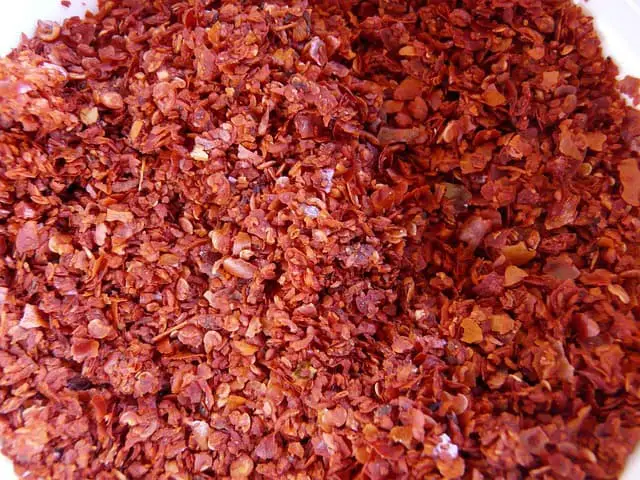Aleppo pepper is a type of chili pepper originating from the city of Aleppo in Syria. It is known for its moderate heat and fruity, slightly tangy flavor. It is used as a spice in Middle Eastern and Mediterranean cuisine, often sprinkled on dishes like kebabs, hummus, and soups.
Aleppo pepper is a favorite spice of the Middle East, with a unique flavor and twang that blends perfectly into all sorts of dishes. Originating in Syria, it has an intense heat that can add a special kick to both savory and sweet recipes.
What is Aleppo Pepper?
Aleppo pepper is a type of crushed red chili pepper that comes from the city of Aleppo in Syria. It has a deep red color, a sweet and slightly smoky flavor, and an moderate heat level that makes it an excellent addition to many dishes. It’s usually sold dried and crushed (though you can also find it whole), which gives it its characteristic vivid color.
The Aleppo Pepper has a Scoville heat rating (SHU) of 10,000 which ranks it as a moderately hot pepper. By comparison a jalapeno pepper is as high as 8,000 SHU although many jalapenos are much lower.
Where Is Aleppo Pepper Grown?
Aleppo pepper is grown mostly in Syria, although some of the peppers are also harvested from Turkey. The peppers are grown in an area near Aleppo, giving rise to the name “Aleppo pepper”.
It’s important to note that Aleppo pepper has been part of Syrian cuisine for centuries, so though cultivation has been disrupted by war and instability in recent years, it remains an important element of Syrian culture.
What Does Aleppo Pepper Taste Like?
Aleppo pepper has a unique flavor that is both smoky and slightly salty, with just the right amount of heat. The peppers are dried and then crushed into small flakes, which range from deep red to yellow-orange in color.
The taste is often described as being similar to crushed red pepper but with a milder, almost fruity kick at the end. It’s usually added after cooking to dishes such as hummus, soups, and stews for added flavor.
How to Use Aleppo Pepper in Cooking
Aleppo pepper is a versatile spice with a mild kick of heat that can be used in many dishes. It’s best when added at the end of the cooking process, as it will lose some of its flavor when exposed to high temperatures.
Sprinkle it over hummus and other dips, add it to roasted vegetables or sprinkle it over grilled meat for an extra layer of flavor. Use Aleppo pepper when adding a smoky punch to kabobs, soups and stews, or mix it into pasta and salads for a spicy kick.
Here are 10 dishes that incorporate Aleppo Pepper:
- Kebabs – Aleppo pepper can be added to kebabs by seasoning the meat mixture before shaping it into skewers or sprinkled on top before grilling.
- Hummus – Aleppo pepper can be added to hummus by mixing it into the chickpea mixture or sprinkled on top before serving.
- Soups – Aleppo pepper can be added to soups by stirring it into the broth during cooking or sprinkled on top as a garnish before serving.
- Stuffed bell peppers – Aleppo pepper can be added to stuffed bell peppers to increase the heat by mixing it into the filling or sprinkled on top before baking.
- Grilled meats – Aleppo pepper can be added to grilled meats by marinating the meat in a mixture containing the spice or sprinkled on top before grilling.
- Rice dishes – Aleppo pepper can be added to rice dishes by mixing it into the cooked rice or sprinkled on top as a garnish before serving.
- Spicy sauces – Aleppo pepper can be added to spicy sauces by blending it into the sauce mixture or stirring it in while cooking.
- Lentil dishes – Aleppo pepper can be added to lentil dishes by mixing it into the lentils while cooking or sprinkled on top as a garnish before serving.
- Salad dressings – Aleppo pepper can be added to salad dressings by blending it into the dressing mixture or sprinkled on top as a garnish for the finished salad.
- Pickled vegetables – Aleppo pepper can be added to pickled vegetables by including it in the pickling liquid or as a sprinkle on top after the pickling process.
Tips for Buying, Storing and Substituting Aleppo Pepper Spice
When buying Aleppo pepper, it is important to check for freshness. Look for a vibrant red color, which indicates that the pepper is fresh and full of flavor. Store Aleppo pepper in an airtight container and away from direct sunlight to ensure maximum freshness and potency.
If you can’t find Aleppo pepper in your local store, then you could substitute it with a combination of crushed red pepper flakes and paprika. It won’t provide the same smoky flavor, but it will deliver a similar level of heat.

